remove seats Citroen C5 2012 (RD/TD) / 2.G Owner's Manual
[x] Cancel search | Manufacturer: CITROEN, Model Year: 2012, Model line: C5, Model: Citroen C5 2012 (RD/TD) / 2.GPages: 316, PDF Size: 9.75 MB
Page 27 of 316
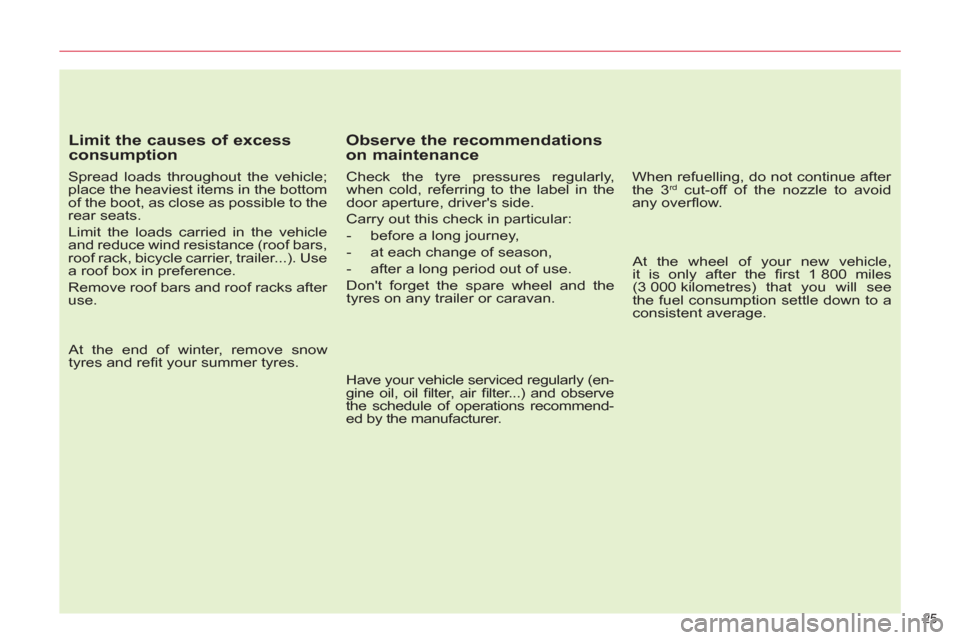
25
Limit the causes of excess
consumption
Spread loads throughout the vehicle;
place the heaviest items in the bottom
of the boot, as close as possible to the
rear seats.
Limit the loads carried in the vehicle
and reduce wind resistance (roof bars,
roof rack, bicycle carrier, trailer...). Use
a roof box in preference.
Remove roof bars and roof racks after
use.
At the end of winter, remove snow
tyres and refi t your summer tyres.
Observe the recommendations
on maintenance
Check the tyre pressures regularly,
when cold, referring to the label in the
door aperture, driver's side.
Carry out this check in particular:
- before a long journey,
- at each change of season,
- after a long period out of use.
Don't forget the spare wheel and the
tyres on any trailer or caravan.
Have your vehicle serviced regularly (en-
gine oil, oil fi lter, air fi lter...) and observe
the schedule of operations recommend-
ed by the manufacturer.
When refuelling, do not continue after
the 3 rd cut-off of the nozzle to avoid
any overfl ow.
At the wheel of your new vehicle,
it is only after the fi rst 1 800 miles
(3 000 kilometres) that you will see
the fuel consumption settle down to a
consistent average.
Page 50 of 316
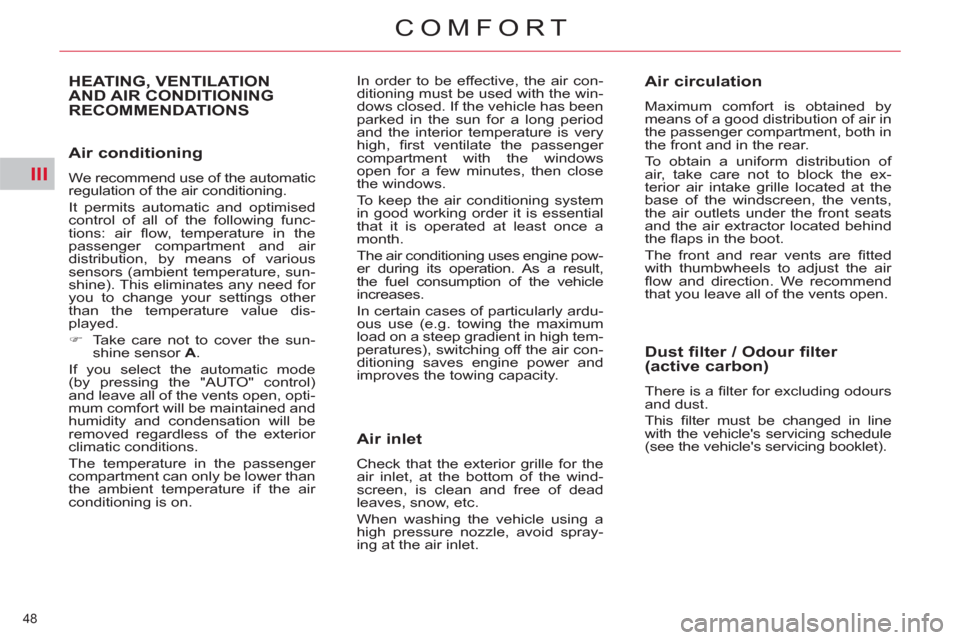
III
48
COMFORT
Air conditioning
We recommend use of the automatic
regulation of the air conditioning.
It permits automatic and optimised
control of all of the following func-
tions: air fl ow, temperature in the
passenger compartment and air
distribution, by means of various
sensors (ambient temperature, sun-
shine). This eliminates any need for
you to change your settings other
than the temperature value dis-
played.
�)
Take care not to cover the sun-
shine sensor A
.
If you select the automatic mode
(by pressing the "AUTO" control)
and leave all of the vents open, opti-
mum comfort will be maintained and
humidity and condensation will be
removed regardless of the exterior
climatic conditions.
The temperature in the passenger
compartment can only be lower than
the ambient temperature if the air
conditioning is on.
HEATING, VENTILATION
AND AIR CONDITIONING
RECOMMENDATIONS In order to be effective, the air con-
ditioning must be used with the win-
dows closed. If the vehicle has been
parked in the sun for a long period
and the interior temperature is very
high, fi rst ventilate the passenger
compartment with the windows
open for a few minutes, then close
the windows.
To keep the air conditioning system
in good working order it is essential
that it is operated at least once a
month.
The air conditioning uses engine pow-
er during its operation. As a result,
the fuel consumption of the vehicle
increases.
In certain cases of particularly ardu-
ous use (e.g. towing the maximum
load on a steep gradient in high tem-
peratures), switching off the air con-
ditioning saves engine power and
improves the towing capacity.
Air inlet
Check that the exterior grille for the
air inlet, at the bottom of the wind-
screen, is clean and free of dead
leaves, snow, etc.
When washing the vehicle using a
high pressure nozzle, avoid spray-
ing at the air inlet.
Air circulation
Maximum comfort is obtained by
means of a good distribution of air in
the passenger compartment, both in
the front and in the rear.
To obtain a uniform distribution of
air, take care not to block the ex-
terior air intake grille located at the
base of the windscreen, the vents,
the air outlets under the front seats
and the air extractor located behind
the fl aps in the boot.
The front and rear vents are fi tted
with thumbwheels to adjust the air
fl ow and direction. We recommend
that you leave all of the vents open.
Dust filter / Odour filter
(active carbon)
There is a fi lter for excluding odours
and dust.
This fi lter must be changed in line
with the vehicle's servicing schedule
(see the vehicle's servicing booklet).
Page 62 of 316
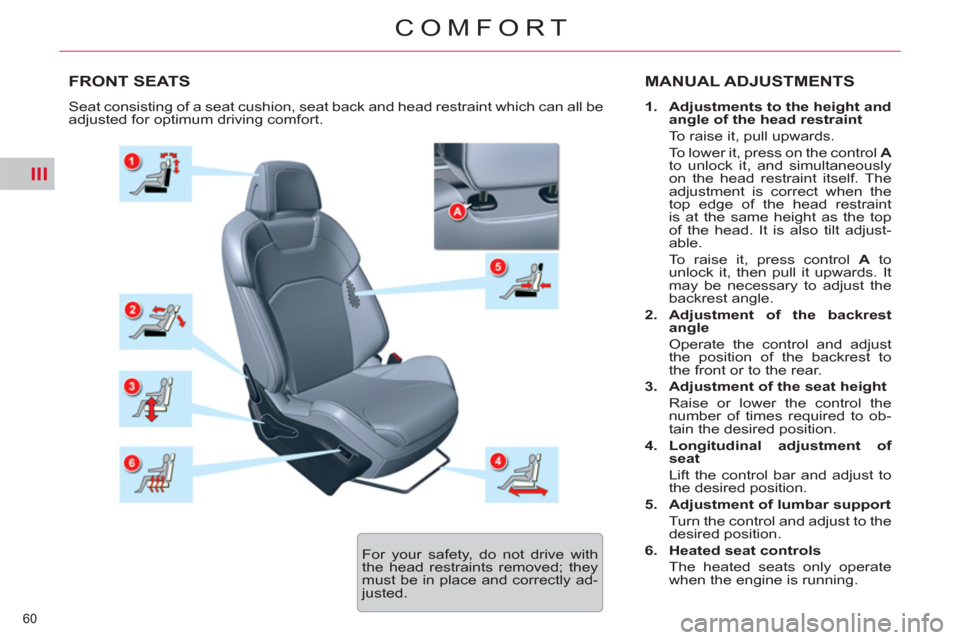
III
60
COMFORT
FRONT SEATS MANUAL ADJUSTMENTS
1.
Adjustments to the height and
angle of the head restraint
To raise it, pull upwards.
To lower it, press on the control A
to unlock it, and simultaneously
on the head restraint itself. The
adjustment is correct when the
top edge of the head restraint
is at the same height as the top
of the head. It is also tilt adjust-
able.
To raise it, press control A
to
unlock it, then pull it upwards. It
may be necessary to adjust the
backrest angle.
2.
Adjustment of the backrest
angle
Operate the control and adjust
the position of the backrest to
the front or to the rear.
3.
Adjustment of the seat height
Raise or lower the control the
number of times required to ob-
tain the desired position.
4.
Longitudinal adjustment of
seat
Lift the control bar and adjust to
the desired position.
5.
Adjustment of lumbar support
Turn the control and adjust to the
desired position.
6.
Heated seat controls
The heated seats only operate
when the engine is running. Seat consisting of a seat cushion, seat back and head restraint which can all be
adjusted for optimum driving comfort.
For your safety, do not drive with
the head restraints removed; they
must be in place and correctly ad-
justed.
Page 63 of 316
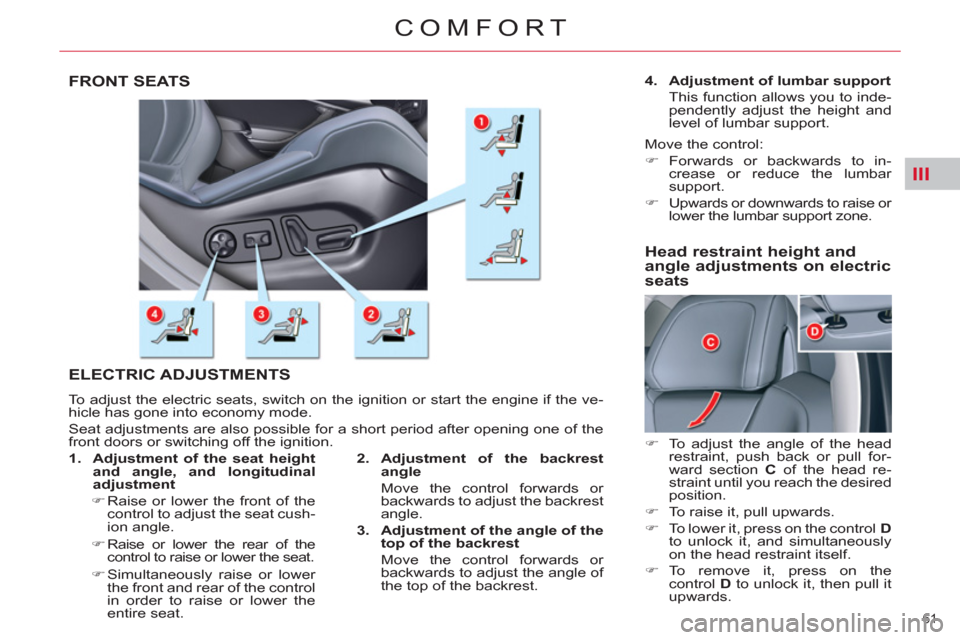
III
61
COMFORT
FRONT SEATS
ELECTRIC ADJUSTMENTS
To adjust the electric seats, switch on the ignition or start the engine if the ve-
hicle has gone into economy mode.
Seat adjustments are also possible for a short period after opening one of the
front doors or switching off the ignition.
2.
Adjustment of the backrest
angle
Move the control forwards or
backwards to adjust the backrest
angle.
3.
Adjustment of the angle of the
top of the backrest
Move the control forwards or
backwards to adjust the angle of
the top of the backrest.
1.
Adjustment of the seat height
and angle, and longitudinal
adjustment
�)
Raise or lower the front of the
control to adjust the seat cush-
ion angle.
�)
Raise or lower the rear of the
control to raise or lower the seat.
�)
Simultaneously raise or lower
the front and rear of the control
in order to raise or lower the
entire seat.
4.
Adjustment of lumbar support
This function allows you to inde-
pendently adjust the height and
level of lumbar support.
Move the control:
�)
Forwards or backwards to in-
crease or reduce the lumbar
support.
�)
Upwards or downwards to raise or
lower the lumbar support zone.
Head restraint height and
angle adjustments on electric
seats
�)
To adjust the angle of the head
restraint, push back or pull for-
ward section C
of the head re-
straint until you reach the desired
position.
�)
To raise it, pull upwards.
�)
To lower it, press on the control D
to unlock it, and simultaneously
on the head restraint itself.
�)
To remove it, press on the
control D
to unlock it, then pull it
upwards.
Page 66 of 316
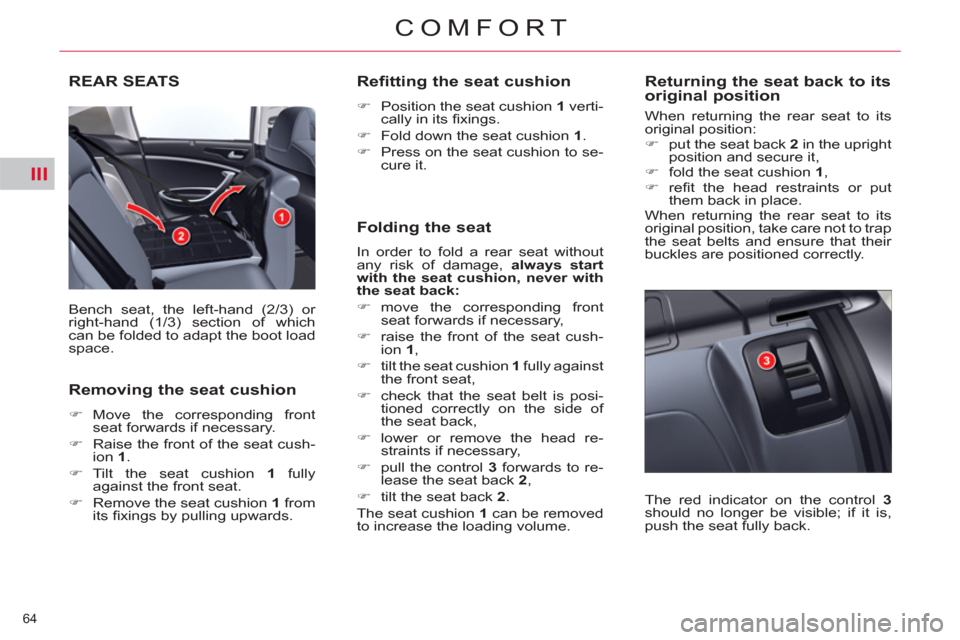
III
64
COMFORT
REAR SEATS
Bench seat, the left-hand (2/3) or
right-hand (1/3) section of which
can be folded to adapt the boot load
space.
Removing the seat cushion
�)
Move the corresponding front
seat forwards if necessary.
�)
Raise the front of the seat cush-
ion 1
.
�)
Tilt the seat cushion 1
fully
against the front seat.
�)
Remove the seat cushion 1
from
its fi xings by pulling upwards.
Refitting the seat cushion
�)
Position the seat cushion 1
verti-
cally in its fi xings.
�)
Fold down the seat cushion 1
.
�)
Press on the seat cushion to se-
cure it.
Folding the seat
In order to fold a rear seat without
any risk of damage, always start
with the seat cushion,
never with
the seat back:
�)
move the corresponding front
seat forwards if necessary,
�)
raise the front of the seat cush-
ion 1
,
�)
tilt the seat cushion 1
fully against
the front seat,
�)
check that the seat belt is posi-
tioned correctly on the side of
the seat back,
�)
lower or remove the head re-
straints if necessary,
�)
pull the control 3
forwards to re-
lease the seat back 2
,
�)
tilt the seat back 2
.
The seat cushion 1
can be removed
to increase the loading volume.
Returning the seat back to its
original position
When returning the rear seat to its
original position:
�)
put the seat back 2
in the upright
position and secure it,
�)
fold the seat cushion 1
,
�)
refi t the head restraints or put
them back in place.
When returning the rear seat to its
original position, take care not to trap
the seat belts and ensure that their
buckles are positioned correctly.
The red indicator on the control 3
should no longer be visible; if it is,
push the seat fully back.
Page 81 of 316
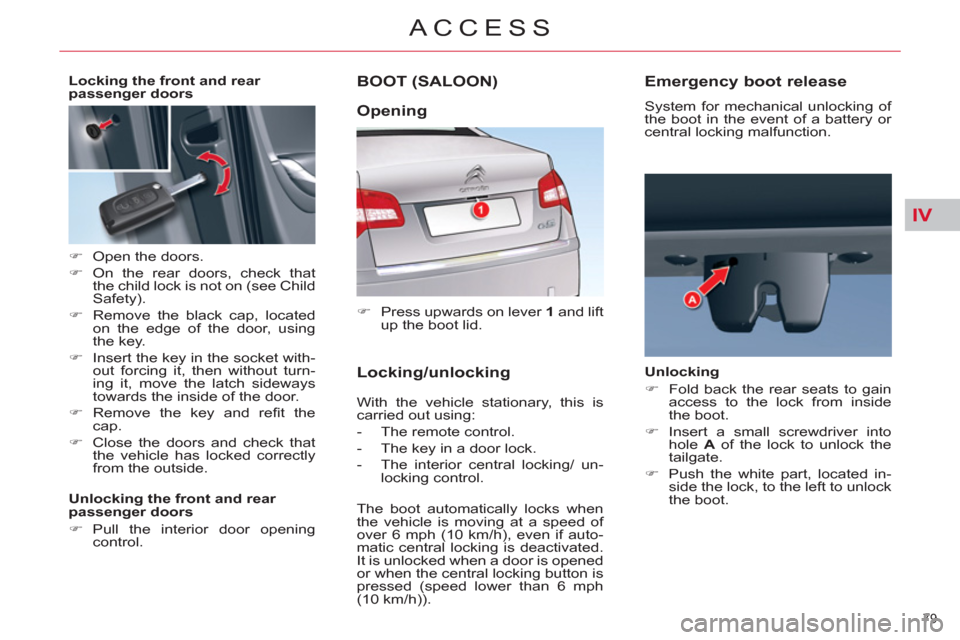
IV
79
ACCESS
BOOT (SALOON)
�)
Press upwards on lever 1
and lift
up the boot lid.
With the vehicle stationary, this is
carried out using:
- The remote control.
- The key in a door lock.
- The interior central locking/ un-
locking control.
The boot automatically locks when
the vehicle is moving at a speed of
over 6 mph (10 km/h), even if auto-
matic central locking is deactivated.
It is unlocked when a door is opened
or when the central locking button is
pressed (speed lower than 6 mph
(10 km/h)).
Opening
Locking/unlocking
Emergency boot release
System for mechanical unlocking of
the boot in the event of a battery or
central locking malfunction.
Unlocking
�)
Fold back the rear seats to gain
access to the lock from inside
the boot.
�)
Insert a small screwdriver into
hole A
of the lock to unlock the
tailgate.
�)
Push the white part, located in-
side the lock, to the left to unlock
the boot.
Locking the front and rear
passenger doors
�)
Open the doors.
�)
On the rear doors, check that
the child lock is not on (see Child
Safety).
�)
Remove the black cap, located
on the edge of the door, using
the key.
�)
Insert the key in the socket with-
out forcing it, then without turn-
ing it, move the latch sideways
towards the inside of the door.
�)
Remove the key and refi t the
cap.
�)
Close the doors and check that
the vehicle has locked correctly
from the outside.
Unlocking the front and rear
passenger doors
�)
Pull the interior door opening
control.
Page 105 of 316
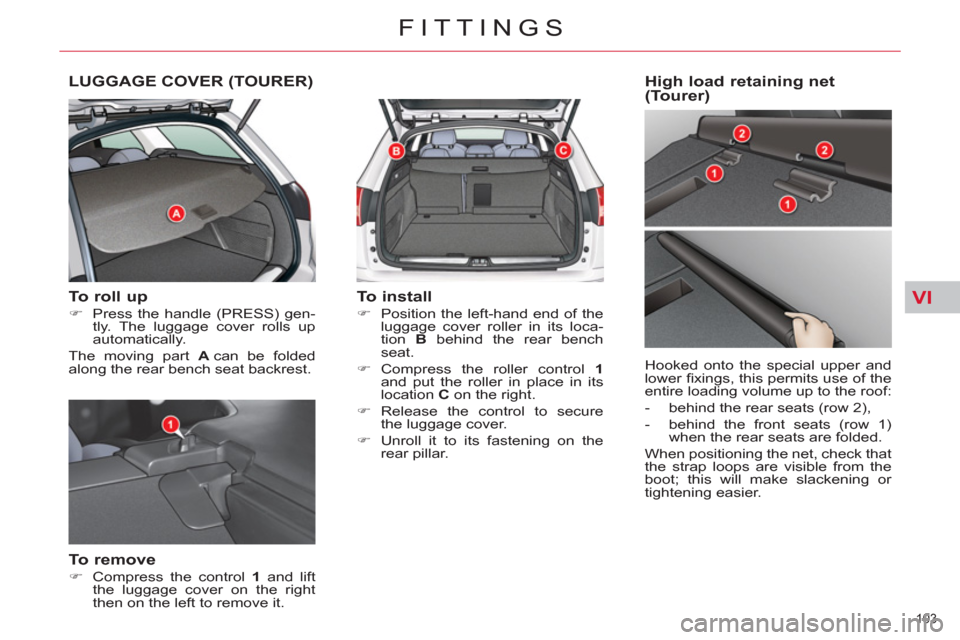
VI
103
FITTINGS
LUGGAGE COVER (TOURER)
To roll up
�)
Press the handle (PRESS) gen-
tly. The luggage cover rolls up
automatically.
The moving part A
can be folded
along the rear bench seat backrest.
To remove
�)
Compress the control 1
and lift
the luggage cover on the right
then on the left to remove it.
To install
�)
Position the left-hand end of the
luggage cover roller in its loca-
tion B
behind the rear bench
seat.
�)
Compress the roller control 1
and put the roller in place in its
location C
on the right.
�)
Release the control to secure
the luggage cover.
�)
Unroll it to its fastening on the
rear pillar.
High load retaining net
(Tourer)
Hooked onto the special upper and
lower fi xings, this permits use of the
entire loading volume up to the roof:
- behind the rear seats (row 2),
- behind the front seats (row 1)
when the rear seats are folded.
When positioning the net, check that
the strap loops are visible from the
boot; this will make slackening or
tightening easier.
Page 127 of 316
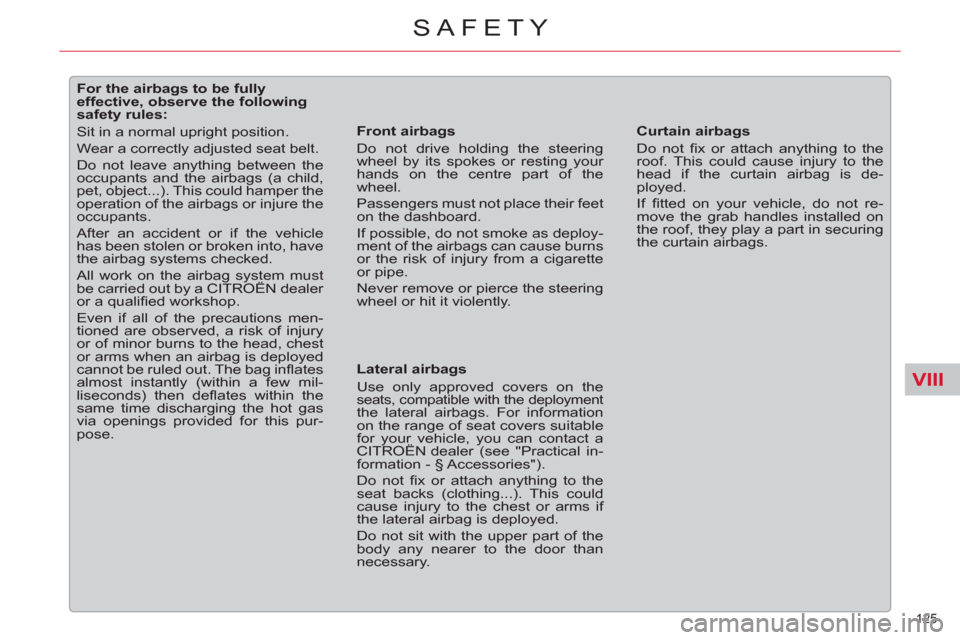
VIII
125
SAFETY
For the airbags to be fully
effective, observe the following
safety rules:
Sit in a normal upright position.
Wear a correctly adjusted seat belt.
Do not leave anything between the
occupants and the airbags (a child,
pet, object...). This could hamper the
operation of the airbags or injure the
occupants.
After an accident or if the vehicle
has been stolen or broken into, have
the airbag systems checked.
All work on the airbag system must
be carried out by a CITROËN dealer
or a qualifi ed workshop.
Even if all of the precautions men-
tioned are observed, a risk of injury
or of minor burns to the head, chest
or arms when an airbag is deployed
cannot be ruled out. The bag infl ates
almost instantly (within a few mil-
liseconds) then defl ates within the
same time discharging the hot gas
via openings provided for this pur-
pose.
Front airbags
Do not drive holding the steering
wheel by its spokes or resting your
hands on the centre part of the
wheel.
Passengers must not place their feet
on the dashboard.
If possible, do not smoke as deploy-
ment of the airbags can cause burns
or the risk of injury from a cigarette
or pipe.
Never remove or pierce the steering
wheel or hit it violently.
Lateral airbags
Use only approved covers on the
seats, compatible with the deployment the lateral airbags. For information
on the range of seat covers suitable
for your vehicle, you can contact a
CITROËN dealer (see "Practical in-
formation - § Accessories").
Do not fi x or attach anything to the
seat backs (clothing...). This could
cause injury to the chest or arms if
the lateral airbag is deployed.
Do not sit with the upper part of the
body any nearer to the door than
necessary.
Curtain airbags
Do not fi x or attach anything to the
roof. This could cause injury to the
head if the curtain airbag is de-
ployed.
If fi tted on your vehicle, do not re-
move the grab handles installed on
the roof, they play a part in securing
the curtain airbags.